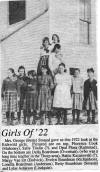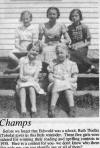Eidsvold School History
[Note: This is a transcription by Paul Forster of an article and
photos that appeared in The Thorp Courier (Number 19) dated Thursday,
March 28, 1991. Paul is the son of “Roy Forester/Ray Forster” mentioned
in the article as a Board Member.]
|
Eidsvold State Graded School Building Remains a Town Landmark
It was shortly before Thorp became a village. There were several
areas in Clark county where people gathered to find relaxation, and
small towns began to form in those areas.
One of those towns still appears on the plat maps of the Town of
Thorp. It is the town of Eidsvold, which at one time had its own post
office, train depot and other important sites.
The Eidsvold School was one of those sites. During the course of its
history it grew like Eidsvold itself, eventually becoming a state graded
school, before the town faded, and took the school with it. It wound
down to a standard school for its last few years before it closed.
|
Early History
A major historian of the Eidsvold area was Jim Clark. Clark provided
histories of the area for a booklet called “Stories of Clark County
Written in the Bicentennial Year.” At the time, he was a resident of
Maple Plain, Minnesota.
He also sent the Thorp Courier a photograph which was run as a “Way
Back When” on December 30, 1976. Accompanying the picture of the class
of 1894 (which we can’t duplicate), is a letter, which describes the
early years of the school. Here are parts of that letter, which was
brought to our attention by Mrs. George Smasal, of Stanley:
“In the year of 1877 School District No. 1 of Thorp was divided
and District No. 2 was formed. The new district included all of the
western half of the town, three miles west of Thorp and about a city
block west and south of what is now (in 1976) Hill Top Tavern. A log
building was constructed, the first term of school began in November
1877, the teacher was Miss Anna Jerard, later Mrs. Mike McCaffrey
who was one of the early settlers in this area. There were nine
pupils, Frank Story, Jeanette Jerard, William Francis, Matt Story,
Elmer Warner, Bill Warner, Elijah Warner, Mittie Warner and Abi
Warner.
“…I remember the building (an old log, one-room schoolhouse) being
there yet when I was a boy, it was occupied as a dwelling by a widow
lady and her two sons, Jim and John Kelly.”
He also noted that the teacher in 1890 was Mary E. Boylan.
Clark gave a letter from original student Bill Warner to Clark, and
it found its way into the “Stories of Clark Co., (etc.)”. That letter
mentions that S. S. Warner of Thorp was a member of the School Board for
18 years; first as a clerk and later as treasurer. The late William
Jerard was also a Board member for years.
Eidsvold became a village, and soon outgrew the log school house,
according to Warner, who reported that the mill company offered the
district a site where the present school is located.
Warner wrote that Boylan was the last teacher in the log school, and
that Miss Marian Gwin was the first teacher of the new building, which
was necessary despite the Eidsvold district again breaking up and
forming the Roger Creek School a few years earlier.
|

Eidsvold 1909
(click to enlarge)
|
Two other schools also formed in the district, but we will
not be covering those three schools, Roger Creek, Junction, and
Pioneer, in this feature series, because there are located in
what is now the Stanley School District
Warner also reported that he was later a teacher at the frame
building. That was around 1894, a year in which there were 62
pupils in the school.In a final note from the early years, we
also know, from information provided by Mrs. George Smasal, that
the teacher from the year 1900 was Mr. Thomas Barber. |
|
School Board Members
We are next able to pick up the history of the Eidsvold School in the
year 1924, where we are able to find the census reports and Clark County
Directory of Schools which provide the names of Board Members. The Board
at Eidsvold was very stable through the years.
Between 1924 and 1960, when the school was closed, there were three
treasurers on the Board. Joe Flore served from prior to 1924 until 1926.
Then Ed Western served from 1926 until the end of the term in 1936. In
1936, Mrs. Muriel Bivans took over, and she served until the school
closed in 1960.
Muriel Bivans has passed away, but her 86-year old husband Loran
still mows the lawn on the grounds of what used to be Eidsvold School.
The (sic) were only four people who served as director during the
last 36 years of the school. Frank Baker served the longest, from 1924
until 1945, when Roy Forester took over. (Forester may be Ray Forster,
who was listed as clerk from 1937-1939). Forester served until 1948, and
was replaced by Paul Cukla until 1952. Robert Kingery was the director
from 1952 until the 1960 consolidation.
Only two persons served extended terms as Clerk. They were William
Endvick, who served from 1924 until sometime in the mid- to late-1920’s
when William Hagen took the post briefly. He was replaced by Endvick
again, who served until 1936.
The other person who served an extensive term was Arthur Evenson, who
served from 1941 until 1957. Other Clerks included Forster, Tora
Boardman, from 1939 to 1941, Garnet W. Smith during the 1957-58 school
year, and William Thill, who served from ’58 until consolidation.
|
Teachers
Thanks to Betty Boardman (Mrs. George Smasal), we have a list of a
few of the teachers before 1933. More specifically, we know that Mr.
Thomas Barber taught in 1900. We also know that between about 1915 and
1923, the teachers included the following:
Sadie Crowley, Margarite Crowley, Irma Mertens, Bertha Van Loo,
Myrtle King, Marian Katt (who was to return to teaching at the
school many years later), Etta McLeod, Miss Becker and Miss Paulson.
|

1915
(click to enlarge)
|
Smasal told us that the switchover to a two
room school came about 1919 or 1920, while she was still a
student there. Smasal said that a new room was built right
alongside the old building to accommodate the new class.
She said that even about 65 years ago discipline in the
classroom could be a problem, as she remembered an occasion when
a student chased a teacher around the classroom with a stick,
while the other students listened through an outdoor vent pipe. |
Because the school was a State graded school for much of its
existence, it was a two room school. The first teacher listed in the
County Directory was considered the “Principal”. The Principal had
administrative duties, and the four older grades, while the “Primary”
teacher was responsible for the first four grades.
|

Girls of '22
(click to enlarge)
|
We get our first look at the teachers starting in the 1933
Clark County Directory. The Principal was Leona Verkuilen, and
the primary teacher was Genevieve Baker. That team stayed
together until 1936-1937 when Ida Markowski (Skalecki) and Ruth
Thielke both took over. In 1939, Miss Ruth Ruggles (Evenson)
became Principal.1940’s
The school started the 1940’s with a fresh staff, as Mrs. Ray
Ropella, and Marion K. Nerdrum took over in 1940, and continued
on until 1942. Nerdrum said that she remembers listening to
President Roosevelt at the start of the second world war. She
also said that hot lunches were provided during her tenure by
Mrs (Irvin) Tora Boardman, who made them with government
commodities.
|
|
During the war years, school was held on Saturday, so that the
children could get out earlier in the spring to help with the farm
chores. She also remembers that Ed Nelson and his wife helped out by
lighting the stove early in the morning.
|

1939 Primary
(click to enlarge)
|
[Transcriber Note: Phyllis (Forster) Dolle of Spokane, WA
contributed a duplicate of the 1939 class photo. Individuals are
identified as follows: Rear. L-R: Tony Kaminski, Gladys Arneson,
Vaughn Forster, Claude Tollefson, Geraldine Anason, Marcella
Daum; Front, L-R: Josephine Kaminsky, Chester Olocki, Colleen
Biddle, Elmwood Arneson, Phyllis Tollefson, Galen Biddle,
Phyllis Forster, Clara Szatalowicz. Rosie Olocki, Teacher Ida
Markowski. Taken in 1939 at Eidsvold State Graded. Note on back
says: Lottie, Lorraine S., Calvin and Steven W. not on.]
|
|

1935 Upper
(click to enlarge)
|
Starting with the 1942-43 school year, the turnover became
more rapid in the facility. Minnie Chaput and Alice
Moldenhauer taught only for the ’42-’43 school year. And they
were replaced by Principal Joseph Kulwiec and Beatrice Steiger.
Steiger stayed on until 1946.
|
|

Champs
(click to enlarge) |
Kulwiec was replaced by Viola Osowski in 1944, and in 1946
she got married and added the name Weslosky. She continued to
teach until 1948 along with Wanda Henderson Rasmussen, who took
over from Steiger. In ‘48 the team became Christine Millus
Jankoski, and Evelyn DeMasters Melman in 1950. There were two
new teachers in ’51-’52 in Sarah Cole Dittner and Ruth Ruggles
Evenson. During that year, the decline in size of Eidsvold and
the parochial school in Thorp began to take a heavy toll, and in
1952, the school converted back to a regular one room school.
|
|

Last Class
(click to enlarge) |
There were only two teachers left in the history of the
district. One was Marie Carpenter Kramer, who taught in 1952-53.
The last one was Mrs. (Harry) Marion Catt Smith, who taught for
the last 8 years of the school’s existence, until 1960. Marion
Catt was also a teacher in the early 1920’s
|
|
Eidsvold School Today
Many of the buildings that we have covered in this series have been
demolished by man or nature, or they are being left to decay where they
stand. The Eidsvold State Graded School is different, it has found
another life.
It was taken over by Donald C. Halterman, who converted it into the
Stanley Truck Sales and Wrecking Yards, otherwise known as the Halterman
Truck Sales and Wrecking Yards. It is plainly visible on CTH X, just
west of the North Fork Bridge.
|

Eidsvold Today
(click to enlarge)
|
Many of the windows are painted over in white,
and a chain crosses the driveway that leads to the front door.
The outhouses that were in the back are old and dilapidated, and
no longer used. It is a place that houses many memories, as it
not only serves as the focus of student memories, but drivers
who go by, and be reminded of a favorite car, which is waiting
to be recycled.
|
|
Next Feature:
Our next feature will be on the Bi-Centennial School. The spelling
was taken from a plat book of the 1940’s and 50’s, which inserted the
hyphen. This school was very close to the City of Thorp, at just one
mile west and half a mile north of the city.
If you have any information, or pictures, of the Bi-Centennial
School, please contact us here at the Courier, and we will try to use it
in our feature article. |
|
|
|